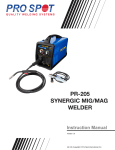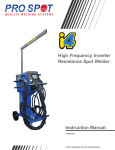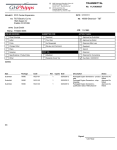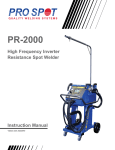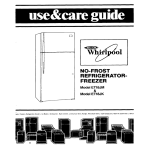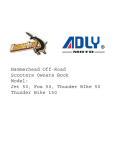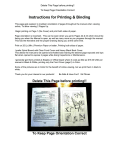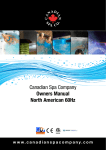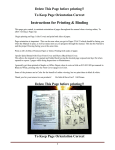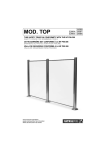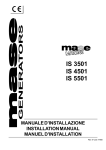Download Pro Spot PHS-101 Instruction manual
Transcript
PHS-101 HYBRID SPOT WELDER Instruction Manual Version 1.0 All Info Copyright © Pro Spot International Inc. About Pro Spot Pro Spot International, Inc., based in Carlsbad, California, manufactures resistance spot welding equipment spe-cializing in applications for the collision repair industry. The company began in 1986. The company owns and manages an on site machine shop, research & development department, a fabrication facility and production lines for the various welders Pro Spot International exports its products worldwide, export sales are managed through our headquarter office. The company owns numerous patents for our ingenious application tools, machines, and procedures. Pro Spot training and services Pro Spot Distributors and Sub-Distributors are carefully selected and are well trained in the collision repair industry. We offer technical and service education at our world wide training facilities at regular intervals so your local distributor will always be up to date and able to pass on the latest in spot welding technology to our customers. Customer service is an important part of any investment and our distributors and sub-distributors will be there to support your technical and service needs. We have a great customer service record, we tend to keep it that way. Pro Spot is certified by CASE and a member of the ICAR Industry Training Alliance Contact Information Pro Spot International, Inc. U.S.A. www.prospot.com 5932 Sea Otter Pl. Carlsbad, CA 92010 2 Phone: +1 760-407-1414 Toll free (US only): 877- PRO SPOT Fax: 760-407-1421 E-Mail: [email protected] All Info Copyright © Pro Spot International Inc. Table of Contents 1.0 SAFETY INFORMATION 1.1 Safety & Environmental Specifications 1.2 General 1.3 Warnings & Important Notices 1.4 Safety Devices 1.4.1 Cooling 5 5 5 7 7 7 2.0 INTRODUCTION 8 3.0 INSTALLATION 10 QUICK START INSTRUCTIONS 3.1 General 3.2 Packaging & Delivery Inspection 3.3 Welder Assembly 3.4 Battery Installation 3.5 Connection of Pneumatic Air Supply 4.0 OPERATION 9 10 10 10 11 12 13 4.1 Before you begin Welding 4.2 About your Welder 4.2.1 Welder Overview & Technical Specifications 4.2.2 Getting Familiar with your Welder 4.2.3 Hybrid Spot Control Panel 4.3 Turning on the Welder 4.4 Choosing the Weld Mode 4.5 Setting the Pneumatic Air Pressure 4.6 User Interface 4.7 System Menu and Advanced Features 4.7.1 Battery Status 4.7.2 Last Weld Info 4.7.3 Weld Count 4.7.4 Alert Set-up 4.7.4.1 Alert Thresholds 4.7.4.2 Alert Indicators 4.7.5 Advanced Set-up 4.7.6 Battery Test 4.7.7 Restore Defaults 4.8 Checking Weld Quality 4.9 Checking Battery 13 14 14 14 15 15 16 16 16 17 17 17 17 18 18 18 19 19 19 20 21 4.9.1 Checking the Battery Voltage 4.9.2 Battery Alerts 21 21 4.9.3 To Remove Side Panel Covers for Service 4.9.4 Checking Battery Water Levels 22 22 All Info Copyright © Pro Spot International Inc. 3 5.0 PS-500 Double-Acting Spot Gun 23 5.1 PS-500 Double Acting Spot Gun 23 5.1.1 PS-500 Component Diagram 5.1.2 Using the Double-Acting Gun 5.2 Extension Arms 24 5.2.1 Switching to Extension Arms 5.2.2 Extension Arms and Welding Electrodes 24 25 5.3 PS-500 Electrode Alignment 5.4 Removing Welding Electrodes 5.5 Welding Electrode Maintenance 5.6 Wheel House Arm 5.7 X-Adapter (optional) 26 27 28 28 29 5.7.1 Attaching the X-Adapter 5.7.2 Using the X-Adapter 5.7.3 X-Adapter Configurations 29 30 30 6.0 Single-Sided Welding 6.1 Single Sided Welding Overview 6.2 Single-Sided Spot Welding 6.3 Bolt Welding 6.4 Nut Welding 6.5 Dent Pulling with Spot Hammer 6.6 Moulding Clip Rivet Welding 6.7 Dent Pulling with Washers and Slide Hammer with Hook 6.8 Contact Shrinking 6.9 Pro Pull Dent Pulling (optional) 6.9.1 Selecting Pro Pull Weld Mode 6.9.2 Pro Pull Component Diagram 6.9.3 Pro Pull Assembly 6.9.4 Dent Pulling with Pro Pull 6.9.5 Paintless Dent Pulling with Pro Pull 4 23 23 31 31 33 33 34 34 35 35 36 37 37 37 38 38 38 7.0 Troubleshooting 39 Notes 40 All Info Copyright © Pro Spot International Inc. SAFETY 1.0 1.1 SAFETY & ENVIRONMENTAL SPECIFICATIONS The Hybrid Spot welder is designed for indoor use. The Hybrid Spot Welder is designed to operate from 10° C to 40° C. Do not operate the unit on a slope of more than 10°. 1.2 GENERAL The Hybrid Spot welder has been designed and is tested to meet strict safety requirements. Please read the following instruction carefully before operating the unit and refer to them as needed to ensure the continued safe operation of the welder. Information provided in this manual describes the suggested best working practices and should in no way take precedence over individual responsibilities or local regulations. The Hybrid Spot Welder is designed to comply with all applicable safety regulations for this type of equipment. During operation, it is always each individual’s responsibility to consider: • Their own and other’s personal safety. • The safety of the welder through correct use of the equipment in accordance with the descriptions and instructions provided in this manual. 1.3 WARNINGS AND IMPORTANT NOTICES The following types of safety signs are used on the equipment and in Pro Spot’s instruction manuals: Caution. Read Instruction Manual. Attention! Lire Mode d’Emploi. Prohibited. Prohibits behaviour that can cause injury. Interdit. Interdit aux comportements qui peuvent provoquer des blessures. Command. Calls for a specific action. Commande. Appelle a une action spécifique. Warning. Notice of personal injury risk and or damage to equipment. Avertissement. Avis de risque de blessure personnelle et / ou d’endommager l’équipement. Warning. Some parts of the welder may become hot long after prolonged use. Avertissement. Certaines parties du soudeur peuvent devenir chaudes aprés une utilisation prolongée. OPEN CIRCUIT VOLTAGE AS IT RELATES TO STATE OF CHARGE Open Circuit Voltage* State of Charge 12.80 or greater.............................100% 12.60..................................75% 12.30..................................50% 12.00..................................25% 12.00....................................0 * The actual stabilized OCV can only be determined after the battery has been disconnected from the charger for 24 hours. Battery Warnings DANGER/POISON SHIELD EYES. EXPLOSIVE GASES CAN CAUSE BLINDNESS OR INJURY. FLUSH EYES SULFURIC IMMEDIATELY ACID WITH WATER. CAN NO CAUSE GET SPARKS MEDICAL FLAMES BLINDNESS OR SMOKING SEVERE BURNS. HELP FAST. READ BEFORE OPERATING WELDER! Connect all 4 cables to negative battery terminals Before using. To access terminals, open right side cover. (The four cables to the negative battery terminals are disconnected during shipping.) KEEP OUT OF REACH OF CHILDREN All Info Copyright © Pro Spot International Inc. 5 SAFETY 1.0 The following warnings and important notices are used in the instruction manual: 6 WARNING! Do not operate or place the welder near water, in wet locations or outdoors. Risk for injuries or damage to the welder. ATTENTION! Ne pas faire fonctionner le soudeur près de l'eau, en voie humide , ou à l’éxterieur . Risque de blessures ou de dommages au soudeur. WARNING! Do not place the welder on unstable or uneven ground. The welder might tip causing personal injuries or serious damage to the welder. ATTENTION! Ne placez pas le soudeur sur un sol instable ou irrégulière. Le soudeur peut basculer causant des lésions corporelles ou des dommages graves au soudeur. WARNING! All electrical connections must be made by a qualified electrician. Risk for electrical shock. ATTENTION! Toutes les connexions électriques doivent être faites par un électricien qualifié. Risque de choc électrique. WARNING! Loose cables and hoses present tripping risks. Risk for injuries. ATTENTION! Câbles et tuyaux lâches présentent des risques de déclenchement. Risque de blessures WARNING! Make sure to use welding goggles when spot welding. The sparks might otherwise injure the eyes. ATTENTION! Veuillez utiliser des lunettes de soudeur sur place. Les étincelles pourraient autrement blesser les yeux. WARNING! Sparks from welding could start a fire. Risk for injuries. ATTENTION! Étincelles de soudure pourrait provoquer une incendie. Risque de blessures. WARNING! Risk for damage to materials close to the weld, e.g to glass or textiles. ATTENTION! Risque de dommages aux matériaux à proximité de la soudure, par exemple verre ou textiles. WARNING! For proper cooling efficiency, never operate the welder without connecting it to the compressed air source. ATTENTION! Pour refroidissement efficace, ne jamais soudeur sans attacher à la source d'air comprimé. WARNING! All service and maintenance must be carried out by Pro Spot service personnel and service support. Risk for electrical shock. ATTENTION! Tout le service et l'entretien doivent être effectués par personnel et soutien de service Pro Spot. Risque de choc électrique. WARNING! Unplug the welder from the wall outlet before servicing, cleaning or maintenance. Risk for electrical shock. ATTENTION! Débranchez le soudeur de la prise murale avant l'entretien, ou nettoyage. Risque de choc électrique. IMPORTANT! The welder may only be used by qualified personnel. The user of the welder must have knowledge of spot welding and of alignment of collision-damaged vehicles. IMPORTANT! Le soudeur peut seulement être utilisé par personnel qualifié. L'utilisateur du soudeur doit avoir une connaissance de soudage par points et l'alignement des véhicules endommagés par collisions. IMPORTANT! Do not turn off the welder while cooling is activated! IMPORTANT! N'éteignez pas le soudeur pendant que le refroidissement est activé! IMPORTANT! The air must be clean and free from oil and moisture. Use filter. IMPORTANT! L'air doit être propre et sans huile et humidité. Utilisez un filtre All Info Copyright © Pro Spot International Inc. SAFETY 1.0 1.3 WARNINGS AND IMPORTANT NOTICES (cont’d.) SHIELD EYES EXPLOSIVE GASES Can cause blindness or injury. NO SPARKS, FLAMES OR SMOKING SULFURIC ACID Can cause blindness or severe burns. FLUSH EYES IMMEDIATELY With Water. Get medical help fast. IF SWALLOWED Drink as much water or milk as possible. Get medical help fast. ! IF SPILLED Spread baking SODA over spill, then dilute with large amounts of water. KEEP OUT OF REACH OF CHILDREN Do Not Tip, Keep Vent Caps Tight And Level PROPOSITION 65 WARNING Battery posts, terminals and related accessories contain lead and lead compounds, chemicals known to the state of California to cause cancer and reproductive harm. Batteries also contain other chemicals known to the state of California to cause cancer. Wash hands after handling. Battery Warnings OPEN CIRCUIT VOLTAGE AS IT RELATES TO STATE OF CHARGE Open Circuit Voltage* State of Charge 12.80 or greater.............................100% 12.60..................................75% 12.30..................................50% 12.00..................................25% 12.00....................................0 * The actual stabilized OCV can only be determined after the battery has been disconnected from the charger for 24 hours. DANGER/POISON SHIELD EYES. EXPLOSIVE GASES CAN CAUSE BLINDNESS OR INJURY. FLUSH EYES SULFURIC IMMEDIATELY ACID WITH WATER. CAN NO CAUSE GET SPARKS MEDICAL FLAMES BLINDNESS OR SMOKING SEVERE BURNS. HELP FAST. KEEP OUT OF REACH OF CHILDREN 1.4 SAFETY DEVICES 1.4.1 Cooling When the Spot Gun is used continuously, the welding cables get hot. To prevent the welder from malfunctioning due to overheating, activate the air cooling system. The air cooling system cools the welding cables, cable ends and the spot gun. In the Home Screen, rotate the Weld Control button to Cooling. Press the Weld Control button to turn ON air cooling.Compressed air will flow through the weld cables. It is not necessary to leave on at all times, but should be used when the weld cables are hot to the touch. For best results, let the welder rest when cables are too hot. Cooler weld cables result in better weld performance. All Info Copyright © Pro Spot International Inc. 7 2.0 INTRODUCTION Congratulations on acquiring your New Hybrid Spot Welder! Team Pro Spot looks forward to supporting you. You have a welder and support group that will increase your productivity. The integrated features, ease of use, speed and quality welds that your Hybrid Spot offers will become an important part of your business. The following information will be needed when you call Pro Spot: *MODEL TYPE: Hybrid Spot *SERIAL NO:______________ (The serial number is located on the back of the unit) For Parts or service contact your local distributor, Local Number: ____________________________ or in the U.S. call toll free: 1-877 PRO SPOT or 1-760-407-1414 for a customer service representative. Visit Pro Spot Online: my.prospot.com Email: [email protected] NOTE: You can now order parts online at: prospot.com/store/ _________________________________________________________________________________________ The Hybrid Spot welder is used by body shops to duplicate the welding procedure used by the car manufacturers. Use of the equipment that is contrary to the instructions in this manual can cause personal injury and/or machine damage. Pro Spot International, Inc. can in no way be held responsible for intentional or unintentional damage, and consequent unlimited loss of profit, loss of income, loss of business opportunity, loss of use, etc. that originates from incorrect use of this equipment in its use in a manner not intended. Warranty Pro Spot International, Inc. offers a two-year guarantee on the welder from the date of delivery. This guarantee covers material defects and assumes normal care and maintenance. The guarantee assumes that: • the equipment is correctly installed and inspected • the equipment has not been altered or rebuilt without approval from Pro Spot International, Inc. • genuine Pro Spot International, Inc. spare parts are used to make repairs. • operation and maintenance has been carried out according to the instructions in this manual. All claims on warranty must verify that the fault has occurred within the guarantee period, and that the unit has been used within its operating range as stated in the specifications. All claims must include the product type and serial number. This data is stamped on the name plate. 8 NOTE: This instruction manual provides instructions for installation, operation, maintenance and troubleshooting. __________________________________________ IMPORTANT! Read this manual carefully to become familiar with the proper operation of the welder. Do not neglect to do this as improper handling may result in personal injury and damage to the equipment. __________________________________________ IMPORTANT! Lisez ce Mode d’Emploi attentivement afin de vous familiariser avec le bon fonctionnement du soudeur. Ne négligez pas de le faire puisque une manvaise manipulation peut conduire aux blessures et dommages à l’équipement. __________________________________________ The drawings in this manual are presented for illustrative purposes only and do not necessarily show the design of the equipment available on the market at any given time. The equipment is intended for use in accordance with current trade practice and appropriate safety regulations. The equipment illustrated in the manual may be changed without prior notice. The contents in this publication can be changed without prior notice. This publication contains information that is protected by copyright laws. No part of this publication may be reproduced, stored in a system for information retrieval or be transmitted in any form, in any manner, without Pro Spot International, Inc.’s written consent. All Info Copyright © Pro Spot International Inc. INTRODUCTION 2.0 Quick Start Instructions Set-up: 1. Connect compressed air no greater than 135 psi to the air inlet located on the back panel. 2. Adjust the regulator knob until the pressure gauge reads 90 psi. Turn Welder On/Off 1. To Turn On: Press Weld Control Button 2. To Turn Off: Unplug Welder, Press and Hold Weld Control Button Welding 1. Rotate the Weld Control button until the cursor points to Weld Time. 2. Press the Weld Control button then rotate it to adjust the Weld Time. For double-sided welding, adjust Weld Time to 260-300 and, for single-sided welding, adjust Weld Time to 120. 3. Press the Weld Control button to commit the change. 4. Repeat steps 1-3 to set your Weld Power. For double-sided welding, adjust Weld Power to Medium or High and, for single-sided welding, adjust weld power to Low or Medium. 5. Place the welding gun at the weld area then press and hold the lower trigger to weld. Press the upper trigger to spread the electrodes open for better access. Charging 1. Plug the power cord in to either 120VAC or 240VAC single phase power to initiate the charge cycle. If the power cord is already plugged in, the charge cycle will begin after a minute of no welding. 2. Unplug the power cord or weld to interrupt the charge cycle. System Display. Shows battery voltage and charge current. WELD TIME: 180 mS WELD POWER: LOW COOLING: OFF System Menu Air Pressure Weld Control Button Air Pressure Regulator Turn Welder On/Off To Turn On : Press Weld Control Button READY To Turn Off : Unplug Welder Press + Hold Weld Control Button All Info Copyright © Pro Spot International Inc. 9 3.0 INSTALLATION 3.1 GENERAL The Hybrid Spot welder is inspected and tested prior to leaving the factory to guarantee consistent quality and the highest possible reliability. Follow the installation tips and operating instructions below to ensure user safety and proper welder performance. WARNING! Do not operate or place the welder near water, in wet locations or outdoors. Risk for injuries or damage to the welder. ATTENTION! Ne pas faire fonctionner le soudeur prés de l’eau, en voie humide ou à l’extérieur. Risque de blessures ou de dommages au soudeur. WARNING! Do not place the welder on unstable or uneven ground. The welder might fall causing personal injuries and damage to the welder. Do not operate on a slope of more than 10°. ATTENTION! Ne placez pas le soudeur sur un sol instable ou irréguiliére. Le soudeur peut tomber causant des dommages graves au soudeur. Ne pas utiliser sur une pente de plus de 10°. IMPORTANT! It is the responsibility of the owner to ensure that the equipment has been installed as specified in the instructions provided. It is also the owner’s responsibility to ensure that the welder is inspected in accordance with applicable regulations before it is put into service. Do not use for thawing out frozen water pipes (17.1). IMPORTANT! C’est la responsabilité du propriétaire de s’assurer que l’équipment a été installé comme specifie dans les instructions fournies. C’est aussi la responsabilité du proprietaire de s’assurer que le soudeur est inspecté conforment à la réglementation applicable avant qu’il ne soit mise en service. Ne pas utiliser pour dégeler les conduites d’eau congelées (17.1). A grounded electrical plug must be installed (refer to section 3.4 “ Connection of electrical supply”). 3.2 PACKAGING AND DELIVERY INSPECTION Check the contents of the shipping container against the packing list, consignment note, or other delivery documentation to verify that everything is included and in the correct quantity. Check the Spot Welder carefully to make sure that no damage has occurred during transport. If anything is damaged or missing, the welder may be unsafe to use until the part is repaired or replaced. If anything is missing, please contact your supplier. Remove all packaging material from the welder. 3.3 WELDER ASSEMBLY Insert the support arm (boom) as shown in Figure 3.1 Figure 3.1 10 All Info Copyright © Pro Spot International Inc. INSTALLATION 3.0 3.4 BATTERY INSTALLATION Preferred Recommended Batteries - Centennial Commercial C-31-10AP CCA1100 Other Recommended Batteries - Deka 31P, P# - 1231PMF, CCA1000, RES 185, REF 1190 When you first receive your hybrid battery spot welder you will need to purchase 4 - Group 31 batteries at >=1000A that have pole style car battery terminals. Remove the 7 screws on both side panels and then remove the panels. Insert batteries from the left side, be sure to check the labels (circled in the image) and set the battery poles facing the correct direction: Negative on RIGHT, Positive on LEFT. The rear lower battery has to be installed from the opening in the back of the welder. Place the leads (red on positive and black on negative) on the battery terminals and tighten with a 1/2” socket. Do not over tighten. All Info Copyright © Pro Spot International Inc. 11 3.0 INSTALLATION 3.5 CONNECTION OF PNEUMATIC AIR SUPPLY The Hybrid Spot welder must be connected to a pneumatic air network. (100 PSI to 130 PSI) 1. Connect the welder to the air supply via the threaded input port at the rear of the welder using a standard connector. 2. If not already set, adjust the air pressure setting on the welder front panel to 90 PSI (4-5 bar) (refer to section 4.5 “Setting the pneumatic air pressure”). IMPORTANT! The air must be clean and free from oil and moisture. Use a filter. IMPORTANT! L’air doit être propre sans huile et humidité, Utilisez un filtre. Air supply port Figure 3.2 12 All Info Copyright © Pro Spot International Inc. OPERATION 4.0 4.1 BEFORE YOU BEGIN WELDING Before you begin welding, be sure to read and understand the following instructions. The Hybrid Spot is a Resistance Spot Welder that was designed for the collision repair industry. It duplicates the welding procedure used by the car manufacturers. It is important to understand the design and function of this welder before operating it. ELECTRICITY ONLY: The welder uses only electricity to create the welds unlike the MIG welder which uses an arc from a feeding wire to build a weld nugget using inert gas and the feeding wire material. PRESSURE: The welder has a built in air cylinder that compresses the Double-Sided Gun’s welding tips together automatically when triggered. The compression is an important part of a good resistance weld. The pressure is adjustable from the Control Panel. The optimum welding pressure varies between 60 - 90 PSI (4-6.5 BAR). 90 PSI seems to be a common starting pressure. As a rule, increase pressure with thicker metals but remember that too much pressure could decrease the resistance of the metal between electrodes resulting in poor weld penetration. CURRENT: Another important aspect of a weld is the current applied through the work piece. A weld is created when a large current is transferred through the layers of sheet metal. The resistance in the metal causes the area to heat up and fuse the sheets together into a nugget. WELD PROGRAM: Maintaining the air pressure after the current shuts off allows the weld to cool down under pressure resulting in a harder, stronger weld. This feature is built in to the welder’s weld control program and is engaged automatically during a weld cycle. TIME: The Timer controls the duration of the current applied during the weld cycle. The idea is to get a weld that uses higher current and shorter time to control heat buildup. WELD CYCLE CHART welder All Info Copyright © Pro Spot International Inc. 13 4.0 OPERATION 4.2 ABOUT YOUR WELDER 4.2.1 Welder Overview & Technical Specifications The welder is supplied with four high performance 12V batteries. Input Voltage: 120VAC or 240VAC 1 Phase 10A Open circuit output voltage 15V max. Welding Amperage: 10,000A max Cable Length: 8’ (2.5m) standard Electrode Pressure: At 6 bars (90 PSI)-280 DaN (616 Lb) At 8 bars (116 PSI)-320 DaN (720 Lb) Cooling System: Air (2 fan), Compressed air The name plate is at the rear of the welder unit. The required voltage is indicated on the label. Welding output is rated at 15V. (weld gun and weld cables) Shipping Weight (standard): 515lb (234kg) - 4 Batteries 240lb (112kg) 4.2.2 Getting Familiar with your welder Double-Sided Gun Holder Tool Box Single-Sided Gun Holder Air Pressure Guage Air Pressure Regulator Weld Control Button Cooling Fans Cable Hook Bracket Fuses Power Input Tool Tray Connect Filtered Air 100 PSI 7 BAR (min) 1 3 2 4 WELD CABLES CONFIGURATION 1. Two-Sided Spot Gun Cable 3. Single-Sided Weld Gun Cable 2. Two-Sided Ground Cable 4. Single-Sided Ground Cable 14 All Info Copyright © Pro Spot International Inc. Back Panel Tool Board OPERATION 4.0 4.2.3 Hybrid Spot Control Panel Batt1 Batt2 Batt3 Batt4 12.40V 12.40V 12.40V 12.40V 1.5A 1.5A 1.5A 1.5A Turn Welder On/Off To Turn On : Press Weld Control Button READY To Turn Off : Unplug Welder Press + Hold Weld Control Button 4.3 TURNING ON THE WELDER To turn on the unit, press the weld control knob on the front panel (do not hold). The welder will run a short self diagnostic then display the HOME screen, when shows the weld time, weld power, and cooling status on the LCD. When the LED next to the Weld Control Button lights up green, the unit is ready to weld. IMPORTANT! Make sure to read the instruction manual before operating the welder. Only trained personnel should use this welder. IMPORTANT! Assurez-vous de lire le Mode d’Emploi avant d’opérer le soudeur. Seul le personnel qualifié devrait utiliser ce soudeur. All Info Copyright © Pro Spot International Inc. 15 4.0 OPERATION 4.4 CHOOSING THE WELD MODE The Hybrid Spot is a multi-functional resistance spot welder. It is equipped with a four weld cable system for your convenience. Two of the weld cables are connected to the Double-Sided Spot Gun and the other two are connected to the Single-Sided Spot Gun. The unit has 3 possible power settings in each mode: Low, Medium, and High. These settings will select the number of batteries used to produce the weld, as shown in the table below: Weld Power Number of Batteries Double-Sided Single-Sided Low 2 1 Medium 3 2 High 4 3 No action is necessary to switch between Single and Double-Sided modes. Simply push the trigger on the gun you want to use, and the welder will automatically select the right number of batteries. Note that in Single-Sided mode, the “Low” power setting should be used for most applications, otherwise excessive heating and burn-through can result. When fewer than 4 batteries are used for a weld, the PHS-101 uses battery management software to determine which batteries have the highest remaining charge so that the strongest possible weld is delivered every time. This balancing software also ensures that the batteries are used evenly, so that no single battery wears down faster than the others. 4.5 SETTING THE PNEUMATIC AIR PRESSURE Pneumatic air is used for: - forcing the spot gun to close and open - cooling the welding cables that are connected to the spot gun. The air pressure is regulated with the air regulator, and the set pressure is indicated on the pressure gauge. Default pressure is 90 PSI. Change the air pressure as follows: 1. Unlock the pressure regulator by pulling on the adjustor knob till it snaps into the unlocked position. 2. Turn the pressure regulator knob clockwise to increase or counter-clockwise to decrease the air pressure. 3. Lock the pressure regulator by pushing the knob into the lock position. 4.6 USER INTERFACE The PHS-101 uses a Weld Control Button to scroll through menu options on the LCD and to change settings. Rotating the Weld Control Button back and forth will move the cursor up and down on the LCD. To use the selected menu option, press the Weld Control Button once (do not hold). If the chosen selection is a numeric setting, the will change appearance to a dark cursor on a light background, indicating that the editing mode is active. Once in this mode, rotate the button until the desired setting is shown, then press the button one more time to save the value and leave editing mode. 16 All Info Copyright © Pro Spot International Inc. OPERATION 4.0 Home Screen: The home screen displays the weld power, weld time, cooling status, and provides an entry point to the System Menu. To set the weld time: 1. Rotate the weld control button to move the cursor to the WELD TIME line on the LCD. 2. Press the Weld Control Button once to enter editing mode, then rotate the knob to adjust weld time in 5 millisecond increments. 3. Once the desired time is shown press the Weld Control Button once to save the setting and exit editing mode. To set the weld power, move the procedure as shown above. cursor to the WELD POWER line of the LCD, then use the same To turn cooling on or off, move the cursor to the COOLING line of the LCD, then press the Weld Control Button to toggle the setting. 4.7 SYSTEM MENU AND ADVANCED FEATURES By clicking on the “System Menu” option at the bottom of the Home screen, the user can access all of the more advanced features and settings available on the PHS-101. These features include diagnostics, operator alerts, and fine-tuning parameters that allow the user to customize the welder to best fit their application. 4.7.1 Battery Status - Selecting this menu option will display the voltage and charging current for all 4 batteries. If the chargers are unplugged, the charge current will show 0. Pressing the Weld Control Button again will return the user to the Home screen. 4.7.2 Last Weld Info The PHS-101 has an integrated current sensor that monitors the true weld current and stores the results of the last weld for diagnostic purposes. Selecting Last Weld Info will display the recorded voltage and weld current for the last weld. Pressing the Weld Control Button again will return the user to the Home screen. 4.7.3 Weld Count Selecting this menu option will display the total number of welds (both Double and Single-Sided) that have been performed on the welder. This is similar to an odometer in that it cannot be reset, even by disconnecting the batteries from the unit. Pressing the Weld Control Button again will return the user to the Home screen. All Info Copyright © Pro Spot International Inc. 17 4.0 OPERATION 4.7.4 Alert Set-up In addition to providing diagnostic information, the built-in current sensor can be used to trigger low-current warnings to alert the operator that current may have been insufficient to form a weld. The Alert Setup menu brings up two sub-menus, Alert Thresholds and Alert Indicators, which allow the trigger levels and alert actions to be set independently. Note that alerts only apply to Double-Sided mode. Single-Sided welding is heavily affected by the surfaces being welded and the placement of the ground electrode, making visual inspection more effective than current monitoring in this mode. 4.7.4.1 Alert Thresholds In this menu the user can set low-current warning levels for each of the 3 power levels. If the weld current drops below the set threshold for a specific power level, the welder will take the action(s) specified in the Alert Indicators Menu. 4.7.4.2 Alert Indicators If the welder detects a low current condition based on the thresholds mentioned above, it will respond based on the following settings: Show Feedback This setting controls the display of weld results on the LCD. Pushing the weld control knob multiple times will cycle through the following options: 1. OFF: Weld results are never shown after a weld, and alerts are disabled. Audible Alert and Weld Cutoff menu options will be hidden. 2. ERR: Results will only be shown if a low current condition is detected. 3. ALL: Results will be shown after all Double-Sided welds, regardless of measured current. Audible Alert When this option is set, an alarm will sound when a low current condition is detected. Weld Cutoff When selected, this option will prevent further welds after a low current condition until the operator presses the weld control knob, returning the unit to the Home screen. The Ready LED will also flash amber during this time. If this option is disabled and the Show Feedback option is set to ERR or ALL, the weld results will be displayed during the cooldown period, reverting automatically to the Home screen when the Ready LED is lit. 18 All Info Copyright © Pro Spot International Inc. OPERATION 4.0 4.7.5 Advanced Set-up From this menu, selecting the Weld Timing option will allow the operator to adjust the following settings: 1. Squeeze Time: The time between the trigger press and the start of weld current to allow the pneumatic cylinder to reach full pressure. This setting only applies to Double-Sided mode. Single-Sided mode uses a fixed half-second delay between the trigger press and the weld. 2. Hold time: The time that the pneumatic gun remains closed after weld current has stopped. This setting only applies to Double-Sided mode. In Single-Sided mode, the operator should maintain pressure on the weld for at about ¼ second after the weld ends to ensure adhesion. 3. Cool Time: The delay between welds to allow the weld cables and gun to cool. The Ready LED will go dark until the cool time has passed, and then illuminate green again. These settings have all been optimized at the factory for best welder performance, so they should only be adjusted if required by a specific application. 4.7.6 Battery Test Selecting this function will run a series of tests to determine the health of the batteries. As a safety feature, the unit will prompt the operator to pull the Double-Sided trigger before the test starts. Make sure that hands and clothing are clear of the weld tips before proceeding. Do not place any metal between the tips, otherwise the test results will be inaccurate. Once the trigger is pushed, the tips will close and the unit will fire 4 welds in a row, one for each battery. When the test is complete, the tips will open automatically and the unit will display the results for battery 1 on the screen. The weld control knob can be used to scroll back and forth to show results for the other three batteries. For a healthy, fully charged battery the measured current should be ≥ 2.8kA and the measured voltage should be ≥ 2.70V. If these criteria are not met, the battery may be worn out or may have too high of an internal resistance to use in the PHS-101. 4.7.7 Restore Defaults To return all welder settings to factory defaults, use this menu option. The unit will prompt the operator before continuing to avoid unintentional loss of custom settings. This function does not clear the weld counter or the current sensor calibration data. All Info Copyright © Pro Spot International Inc. 19 4.0 OPERATION 4.8 CHECKING WELD QUALITY Peel Test To perform destructive weld testing: Make a weld on two test pieces and tear them apart using a Vise & Vise-Grip pliers. Note the strenth of the weld. It is important to test the same materials that you would normally use for repair in a weld destructive testing procedure. Expect to tear a weld nugget as the two metals are peeled apart. IMPORTANT: Use the same metal as you are welding. 20 All Info Copyright © Pro Spot International Inc. OPERATION 4.0 4.9 Battery Maintenance 4.9.1 Checking the Battery Voltage The Hybrid Spot welder is equipped with an on-board charging system that will charge all 4 batteries at once. To activate charging, simply plug in the power cord to the outlet on the back of the welder Fig 3.2 and the supply 120VAC or 240VAC for Europe, Australia, and China. The power supply switches automatically between 120VAC and 240VAC. The charger cooling fans on the back of the unit will turn on automatically when any charger is delivering more than 5 Amps to a battery, and will turn off when no charger is delivering more than 4 Amps. This may happen several times during a single charging cycle. It is possible to weld while the charging is activated; the charger will automatically switch off when welding. The chargers will turn back on 1 minute after the last weld is made. NOTE: While the welder is plugged in, it is not possible to turn the unit off using the Weld Control Button on the front panel. To turn the welder off, first unplug the power cord. If the Weld Control Button was not pressed during charging, the welder will turn off automatically a few seconds after power is removed. Otherwise, press and hold the Weld Control Button as normal to turn the unit off. The welder may be left plugged in constantly; this will not damage the batteries. 4.9.2 Battery Alerts During the charge cycle or welder operation, the LCD may display status alerts to indicate when user action is necessary to keep the batteries in good condition. These alerts are described below: Batt1 Batt2 Batt3 Batt4 Low Battery 12.40V 0.0A 12.40V 0.0A 12.40V 0.0A Fig. 2 Batt1 Batt2 Batt3 Batt4 12.40V 0.0A SERVICE 12.40V 0.0A 12.40V 0.0A Fig. 3 LOW VOLTAGE This alert indicates that the battery has reached the maximum safe discharge level and needs to be charged (Fig. 2). The welder will disable the depleted battery and sound an audible alert if the operator tries to use this battery to weld. Any batteries not showing this alert can still be used to weld. To clear this alert, plug in the power cord and allow the batteries to charge. When any low battery is recharged to at least 13.8V, the alert will clear automatically and welding can resume. SERVICE This alert indicates that the battery voltage has fallen below 11.5V and the battery needs to be replaced (Fig.3). All Info Copyright © Pro Spot International Inc. 21 4.0 OPERATION 4.9.3 To remove side panel covers for service: NOTE: Remove all tools from tool boards on side & rear panels before proceeding. Fig. B Bolts (7) Rear Panel Removal: Start with rear toolboard panel removal, tap bottom Tool Board of toolboard with rubber mallet in an upward motion to loosen from slots (Fit. A). After toolbard is removed, remove two top screws in rear panel cover plate and loosen two bottom screws - remove panel. NOTE: do not remove battery cables to check water levels. Tool Board Side Panel Fig. A Rear Panel Side Panel Removal: Remove 7 bolts located on side panel (Fig. B). To remove panel, pull away from welder and maneuver downward to clear the handle on the welder. Repeat for opposite side. 4.9.4 Checking Battery Water Levels (Always refer first to the battery manufacturers safety and Maintenance manual) The charging process can result in a normal gradual depletion of the water levels in the welder batteries. It is very important to keep the distilled water level within specification. Do not let the water level go too low, this will reduce battery life and could destroy the battery. When the cell inside the battery have been exposed to air, the cell is most likely damaged and cannot be recovered even if water is filled. Check level every six months. To check water level, follow steps below. Only slide battery halfway out. Inspect 3 cells, repeat on other side. DO NOT REMOVE BATTERY CABLES when servicing batteries. To check water levels, remove side panel covers from welder (reer to 4.3.2). Slide each battery out one at a time approximately 6 inches from tray, enough to expose 3 battery cells. Remove the three cell caps that are accessible, check water level with flashlight and fill if necessary. If low, fill with distilled water to the edge of vent well. Do not fill more than 1/8” (2mm) from the bottom of the vent well. Repeat steps to service remaining 3 cells. WARNING: DO NOT LET ACID TOUCH SKIN OR EYES Remove L-Bracket Only NOTE: Only slide 1 battery out at a time. Turn each fill-plug counter clockwise and remove. Do not fill more than 1/8” (2mm) above the bottom of the vent well. Overfilling will cause battery failure. 1/8” (2mm) DO NOT OVERFILL 22 All Info Copyright © Pro Spot International Inc. DOUBLE-SIDED WELDING 5.0 5.1 PS-500 DOUBLE-ACTING SPOT GUN The spot gun can be used to weld the following metals: • HSS Galvanized Steel, Mild Steel, Weld Bonding, Boron Steel. 5.1.1 PS-500 Component Diagram PS-302 C-Arm F-44 Release Trigger Switch F-44 Weld Trigger Switch Weld Shaft PS-103-CM 20mm Shank PS-025 Welding Cap PS-1101-CM 60mm Shank PS-5203 Clamping Handle Figure 5.1 PS-500 Spot Gun - Component Diagram 5.1.2 Using the Double-Acting Gun Push this button to open electrodes wide. Push this button to close electrodes and weld. All Info Copyright © Pro Spot International Inc. 23 5.0 DOUBLE-SIDED WELDING 5.2 Extension Arms The Hybrid Spot comes with a variety of extension arms to accomodate any welding configuration. Please refer to Fig. 5.3 for details on what welding electrodes to use with each extension arm. NOTE: Extension arms marked “optional” are available from your local distributor or online at www.prospot.com. REMARQUE: bras d’extension portant la mention <<facultatif>> sont disponibles à partir de votre Distributeur régional ou en ligne à www.prospot.com Figure 5.2 Hybrid Spot Extension Arms PS-306 (optional) PS-305 508mm Extension Arm PS-52 Wheelhouse Arm PS-302 C-Arm PS-503-W (optional) PS-403 (optional) C-X Adapter 5.2.1 Switching to extension arms Loosen the handle and pull off the C-arm... 24 Now, insert the extension arm and tighten the handle. All Info Copyright © Pro Spot International Inc. DOUBLE-SIDED WELDING 5.0 5.2.2 Extension Arms and Welding Electrodes Different extension arms require the use of different welding electrodes. Use charts in Fig. 5.3 and 5.4 to determine the correct combination of extension arms and welding electrodes. IMPORTANT! Using incorrect welding electrodes with extension arms may result in weak welds and/or damage to your welder. IMPORTANT! En utilisant de électrodes de soudage inexactes au bras d’extension peut donner des soudures faibles et / ou endommager voltre soudeur. A A B C B C PS-302 PS-1101-CM PS-103-CM PS-52-5/8 PS-1101-CM PS-1133-5/8 PS-403 see Sec. 5.7.3 see Sec. 5.7.3 PS-305 PS-1101-CM PS-129-CM PS-503-W PS-1101-CM PS-128-CM Figure 5.3 Extension arm - Welding electrode configuration chart Figure 5.4 Welding electrode selection chart NOTE: PS-025 Welding Caps can be purchased in packages of 15 from your local distributor or online at www.prospot.com REMARQUE: PS-025 caps de soudure peuvent être achetés en paquets de 15 à partir de votre distributeur local ou en ligne à www.prospot.com All Info Copyright © Pro Spot International Inc. 25 5.0 DOUBLE-SIDED WELDING 5.3 PS-500 Electrode Alignment Use the set screws (A, B, C) to align the electrodes. Ex: to move electrode down, loosent screw (C) and tighten screws (A and B). Figure 5.5 Electrode Alignment CORRECT WRONG IMPORTANT! Always maintain proper electrode alignment. Not doing so may result in weak, substandard welds! IMPORTANT! Toujours maintenir l’alignement des électrodes appropriées. Ne pas le faire peut conduire aux aoudures faibles de qualité inférieure! 26 All Info Copyright © Pro Spot International Inc. DOUBLE-SIDED WELDING 5.0 5.4 REMOVING WELDING ELECTRODES Removing Extension Arm Electrode Figure 5.6a: Removing Piston Electrode The extension arm electrodes can be easily removed by lightly tapping them with a pin and hammer as shown in Fig. 5.6 To remove the piston electrode: 1. Grip piston electrode with a set of pliers or vise-grips (Fig. 5.6a) 2. Rock the pliers back and forth to loosen the electrode from the holder. 3. Remove the electrode NOTE: Vise-Grips shown in Fig. 5.6a are specially designed to hold round objects without damaging or scarring them. You can purchase a set from your local distributor or online at: www.prospot.com IMPORTANT! Do not attempt to remove the electrode by hitting it. This could damage the electrode and the spot gun. Figure 5.6b: Removing Welding Cap IMPORTANT! N’essayez pas de retirer l’électrode en la frappant. Cela pourrait endommager l’electrode et le “pistolet”. Rmoving Weld Caps To remove a welding cap: 1. Hold piston electrode with a set of pliers or vise-grips. 2. Grip welding cap with another set of pliers or wedge side cutters between caps and shank as shown in Fig. 5.6b 3. Twist the two to loosen and remove the welding cap. NOTE: An optional welding electrode cap removal tool is available, which makes cap removal easy (Fig. 5.6c). You can order the cap removal tool from your local distributor or online at: www.prospot.com Figure 5.6c: Optional Weld Cap Removal Tool NOTE: Une option d’un outil pour enlever le bouchon est disponible, Pour faciliter le retrait du bouchon (Fig 5.6c) Vous pouvez commander cet outil de votre distributeur local ou en ligne à l’adresse: www.prospot.com Welding Cap Piston Electrode Extension Arm Electrode Figure 5.6 Removing Welding Electrodes All Info Copyright © Pro Spot International Inc. Pin 27 5.0 DOUBLE-SIDED WELDING 5.5 WELDING ELECTRODE MAINTENANCE To maintain structurally-sound welds it is important to keep your welding electrodes clear from build-up. It is also important to maintain a 6mm weld nugget diameter. Clean electrodes with a file and periodically replace welding caps as explained in Secion 5.4 “Removing Welding Electrodes”. Also Available: Pro Spot PLT-50/A Pneumatic Low Profile Dresser sharpens your dull tips without having to remove the arm (Fig. 1) WARNING! The electrodes may be hot. Use caution when handling them. ATTENTION! Les électrodes peuvent être chauds. Soyez prudent lors de leur manipulation. Fig. 1 5.6 WHEEL HOUSE ARM The wheel house adapter allows access to hard to reach areas such as the wheel house. PS-52-5/8: Wheel House Arm PS-1101-CM: 60mm Electrode Shank 28 PS-1133-5/8: Electrode All Info Copyright © Pro Spot International Inc. DOUBLE-SIDED WELDING 5.0 5.7 X-ADAPTER (optional) C-TYPE GUN The advantage of the C-Type Spot Gun is that when making vertical pinch welds on quarter panels, rocker panels, door pillars, etc., the spot gun is positioned perpendicular to the work area. Easy to reach! Easy to use! X-TYPE GUN The X-type design is used on certain applications where the C-type can’t reach. 90% of all welding needs can be done with the C-type but for some radiator radiator support and truck bed pinch welds, the X-Adapter works better. This new invention makes it possible to weld where you never could before! 5.7.1 Attaching the X-Adapter 1 2 3 A Loosen the handle and pull out C-arm... 4 C B Follow instructions in Sec. 5.4 to remove piston electrode Insert the X-Adapter onto the gun.Tighten handle (A). 5 D D Insert the Tapered Electrode (B) into the Shaft (C). Apply air (carefully) to put pressure on the electrodes so that Tapered Electrode seats firmly in the shaft before tightening the Collar (D) set screw. Tighten the Collar (D) set screw. IMPORTANT! Do not tighten the Collar before the inserting Tapered Electrode into the shaft. The collar is designed to prevent the Tapered Electrode from falling out of the Shaft when the gun is fully opened. IMPORTANT! Ne serrez pas le collier avant de glisser l’ Électrode Rétreci dans le tube. Le collier est conçu pour empêcher l’ Électrode Rétreci de tomber du tube quand le pistolet est completement ouvert. All Info Copyright © Pro Spot International Inc. 29 5.0 DOUBLE-SIDED WELDING 5.7.2 Using the X-Adapter Push the upper switch to open electrodes wide. Push the lower switch to close electrodes and weld. 5.7.3 X-Adapter Configurations X Adapter (PS-404) 90° Electrode - Upper (PS-411) PS-024 Welding Cap Collar (PS-407) 90°Electrode - Lower Pivot Axle (PS-412) (PS-406) Figure 5.7 90° Arm Set 30 45° Electrode - Upper (PS-421) Tapered Electrode (PS-405) 45°Electrode - Lower (PS-422) Figure 5.8 45° Arm Set All Info Copyright © Pro Spot International Inc. SINGLE-SIDED WELDING 6.0 6.1 SINGLE-SIDED WELDING OVERVIEW (Not recommended for structural welding, for cosmetic only.) ground plate The Single-Sided Weld System allows the operator to carry out welding tasks using a Single-Sided Weld Gun. The Single-Sided weld procedure requires contact only from one side compared to two sides in Two-Sided welding. A ground plate must be connected to the panel to be welded for it to work (Fig. 6.1). You can also use an optional magnetic ground plate to easily attach the ground cable to the metal (Fig. 6.1b). NOTE: Make sure the ground plate is clamped firmly in place on the inside of a clean metal surface as near as possible to the weld location. Do not attach the ground to the metal you’re about to weld on. When performing other weld tasks such as dent pulling, etc., the ground attachment location becomes less critical. Figure 6.1 REMARQUE: Assurez-vous que la plaque de terre est serré solidement en place a l’intérieur d’une surface métallique propre aussi prés que possible du leu du soudure. Ne fixez pas le terre et le métal que vous êtes sur le point de soudure. En accomplissant d’autres tâches comme la soudure dent de traction, etc, le lieu de saisie devient moins critique. Figure 6.1b In the Single-Sided weld mode the following weld procedures are available for the Hybrid Spot: Single-Sided Welding (cosmetic repair only) Washer Welding Nail Welding Contact Shrinking Bolt and Nut Welding Rivet Welding Spot Hammer Dent Pulling Pro Pull Dent Removal Figure 6.2 Single-Sided applications All Info Copyright © Pro Spot International Inc. 31 6.0 SINGLE-SIDED WELDING Single Sided Welding Reference: For single sided welding with the Hybrid Spot, it is important to not use too high of a power for the first time setting, otherwise the current will burn through the weld surface and leave a hole. As a general guideline for most single sided welds, start with Weld Power set to LOW and the weld time set to 120 mS. For dent pulling only, start with the lowest time setting available. If less power is needed, try to seperate the ground cable further away from the weld area to create more power resistance and/or use the pointed spot hammer tip to spread out the heat zone. 32 All Info Copyright © Pro Spot International Inc. SINGLE-SIDED WELDING 6.0 6.2 SINGLE-SIDED SPOT WELDING Single-Sided spot welding is used where Two-Sided welding cannot be used. IMPORTANT: The Single-Sided spot welding is not permitted on supporting frameworks of a vehicle. It is only permitted for cosmetic purposes. IMPORTANT: Le soudage de Côté Unique par points n’est pas autorisée sur les cadres de soutien d’un véhicule. Il est seulement permis a des fins cosmétiques. Figure 6.9 1. Select Weld Power to Low (Medium use 250ms, Avoid using too much pressure or you will punch through the hood) 2. Fit the Single-Sided Gun with Single-Sided electrode (Fit. 6.9). 3. Grind between the inner and outer body sheets to remove paint, primer and rust. This ensures good electrical contact when performing Single-Sided welding. 4. Ground the working area (refer to section 6.1 “Single-Sided Welding Overview”). 5. Apply about 33-44 lbs of pressure on the Single-Sided gun and push the tirgger to weld. Reposition and weld again. NOTE: Make sure that Single-Sided electrode is clean. If it isn’t, use a file or tip dresser to clean it. If the weld cap shows considerable wear, it should be replaced (refer to section 5.4 “Removing Welding Electrodes”). REMARQUE: Assurez-vous que l’électrode Côté Unique est propre. Si ce n’est pas, utilisez une lime pour le nettoyer. Si le bouchon de soudure est considerablement usé, il devrait être remplace (voir la section 5.4 “Enlévement d’Electrodes de soudage”). 6.3 BOLT WELDING Many of today’s car bodies come with factory equipped threaded studs. After a collision, the studs may be lost or do not accompany the replacement part. With the Hybrid Spot, threaded studs can be welded-on in factory style. This type of stud is also common throughout the car body for attachments of interior, tail lights, door moldings, etc. Figure 6.12 TIP: A threaded stud can also be used to fasten the ground clamp directly to the panel, minimizing the area needed for grinding. Astuce: Un goujon fileté peut également être utilisé pour fixer la pince directement sur le panneau, ce qui réduit la surface nécessaire au broyage. Studs are held in place during welding with magnetic adapter electrode. 1. Select Weld Power to Low (Wider Bolts use 200ms, Smaller Bolts use 120ms). 2. Fit Single-Sided gun with the magnetic stud adapter (Fig. 6.12). 3. Insert stud into the adapter (Fig. 6.12). 4. Prepare the surface area by removing paint and primer. 5. Ground the work area (refer to section 6.1 “Single-Sided Welding Overview”) 6. Position Single-Sided gun over work area and push the trigger to weld. 7. Repeat as needed. All Info Copyright © Pro Spot International Inc. 33 6.0 SINGLE-SIDED WELDING 6.4 Nut Welding Weld-on nuts are common throughout the car body for attachments of interior, tail lights, door moldings, etc. and are applied with ease using the Hybrid Spot. TIP: Different size nuts are available from your local Pro Spot distributor or on the web at: www.prospot.com Figure 6.15 ASTUCE: noix de diffèrentes tailles sont disponibles chez votre distributeur local Spot Pro ou sur le web à la boutique Pro Spot en ligne. Nuts are held in place during welding with a shrinking electrode. 1. Select Weld Power to Low (200-250ms) 2. Fit Single-Sided gun with the Shrink Electrode (Fig. 6.15). 3. Prepare the surface area by removing paint and primer. 4. Ground the working area (refer to section 6.1 “Single-Sided Welding Overview”). 5. Press weld-on nut to the metal with Contact Shrinking electrode, apply some pressure and push the trigger to weld. 6. Repeat as needed. 6.5 DENT PULLING WITH SPOT HAMMER Spot hammer dent pulling is used to repair dents on a vehicle body, The spot hammer welds directly onto the work area and pulls the dent. TIP: The replaceable welding tip should last for over one thousand welds. Contact your local distributor to order replacement tips, or order online at: www.prospot.com ASTUCE: Le bout de soudage remplaçable devrait durer plus d’un millier soudures. Contactez votre distributeur local pour commander pointes de rechange, ou commandez sur la Web Pro Spot au magasin en ligne. Figure 6.18 1. Select Weld Power to Low/Medium (100ms) 2. Fit Single-Sided gun with the spot hammer (Fig. 6.18). 3. Prepare the dent surface area by removing paint and primer. 4. Ground the working area (refer to section 6.1 “Single-Sided Welding Overview”). 5. Position the spot hammer tip at the bottom of the dent and push the trigger to weld the electrode onto the metal. 6. Pull out a dent then release by twisting the hammer. 7. If needed, reposition, weld and pull again. NOTE: Check spot hammer tip periodically to make sure it is in good working order. If the tip looks worn, replace it with a new one. NOTE: Contrôlez le bout marteau pèriodiquement pour s’assurer qu’il est en bon ètat de marche. Si le bout semble usè, le remplacer par un nouveau. 34 All Info Copyright © Pro Spot International Inc. SINGLE-SIDED WELDING 6.0 6.6 MOULDING CLIP RIVET WELDING Figure 6.21 This function will weld on factory type clips for the window moulding. The clips that hold the moulding do not, usually, come on the replacement parts. Rivets are held in place during welding with magnetic adapter electrode. 1. Select Weld Power to Low (100ms) Recommendation: When welding Clip Rivets, move the ground cable as far away from the weld area as possible. 2. Select Rivet Welding Program by pressing the Left or Right Navigation Buttons 3. Choose weld power level by pressing the “Next Program” button repeatedly. 4. Fit Single-Sided gun with the magnetic rivet adapter (Fit. 6.21). 5. Insert rivet into the adapter ( Fig. 6.21). 6. Prepare the surface area by removing paint and primer. 7. Ground the working area (refer to section 6.1 “Single-Sided Welding Overview”). 8. Position Single-Sided gun over work area and push the trigger to weld. 9. Repeat as needed. 6.7 DENT PULLING WITH WASHERS AND SLIDE HAMMER WITH HOOK The slide hammer with hook (optional) can be used in conjunction with washers to repair car body dents. TIP: You can purchase a slide hammer with hook from your local Pro Spot distributor or on the web at: www.prospot.com Figure 6.24 ASTUCE: Vous pouvez acheter un marteau glissant avec crochet de votre distributeur locale Pro Spot ou sur le web à la boutique Pro Spot en ligne. Washers are held in place during welding with magnetic adapter electrode. 1. Select Weld Power to Low (175ms) 2. Fit Single-Sided gun with the magnetic washer adapter (Fig. 6.24). 3. Insert washer into the adapter (Fig. 6.24). 4. Prepare the dent surface area by removing paint and primer. When welding on washers, you only need to clean the area where the washer touches the metal since the grounding system is connected through a seperate cable. 5. Gound the working area (refer to section 6.1 “Single-Sided Welding Overview”). 6. Position the washer at the bottom of the dent and push the trigger to weld the washer onto the metal. 7. Hook the washer with the slide hammer and pull the dent out. 8. Repeat as needed. TIP: You can, also, pull multiple washers by welding on a tow of washers at the bottom of the dent, inserting a rod through the washers and pulling the rod with the slide hammer with hook. ASTUCE: Vous pouvez, ègalement, tirer plusieurs rondelles par soudage sur une rangèe de rondelles au bas de la Dent, insertant une baguette par les rondelles et en tirant la tige avec le marteau glissqnt avec crochet. All Info Copyright © Pro Spot International Inc. 35 6.0 SINGLE-SIDED WELDING 6.8 CONTACT SHRINKING Dent pullng with washers creates high spots in the metal. Until now, the common practice would have been to grind the surface, resulting in a lot of sheet metal thickness. With the Hybrid Spot, use the shrinking tip instead of a grinder to remove the high spots, leaving a smooth and clean surface that is every bit as thick and strong as before. Shrinking electrode also acts as a nut adapter (6.4 “Nut Welding”). With this electrode you get two convenient tools in one. Figure 6.27 36 1. Select Weld Power to Medium (150-200ms) 2. Fit Single-Sided gun with the contact shrinking electrode 3. Prepare the surface area by removing paint and primer. 4. Ground the working area (refer to section 6.1 “Single-Sided Welding Overview”). 5. Position the contact shrink electrode over the high spot, apply some pressure and push the trigger to weld. 6. Repeat as needed. All Info Copyright © Pro Spot International Inc. SINGLE-SIDED WELDING 6.0 6.9 PRO PULL DENT PULLING (Optional) e ll can b Pro Pu most to d e tt fi ers ot weld nce sp resista nt pullers. or de ters & Adap Welder luded. c in not Pro pull is a patented, innovative tool for fast and accurate dent pulling. It features paintless dent removal functionality (see sec. 6.3.5 “Paintless Dent Pulling with Pro Pull”). 6.9.1 Selecting Pro Pull Weld Mode Make sure the ground plate is clamped firmly in place on the inside of a clean metal surface as near as possible to the wld location NOTE: Do not attach the ground to the metal you’re about ot weld on. When performing other weld tasks such as dent pulling, etc., the ground attachment location becomes less critical. Assurez-vous que la plaque de terre est serrè fermement en place à l’intèrieur d’une surface propre de mètal le plus près que possible au ieu de soudure. NOTE: Ne fixez pas le terre et le mètal que vous êtes sur le point de soudre. Lors de l’exècution d’autres tâches comme la soudure dent de traction, etc, le terre du lieu de saisie devient moins critique. 6.9.2 Pro Pull Component Diagram Pro Pull comes with three different Blocking Plates with Quick-Connect design. Block window size: 2.5"(63mm) x 1.5"(38mm) PP-10-04 Retrofit point for different end adapters. Available for most weld guns. (not included) See prospot.com for more information. Large openings for great visual control of the pulling area. Block window size: 1.75"(44mm) x 1"(25mm) PP-10-03 CLT-55 Electrode Block window size: 0.75" (19mm) dia. PP-10-01 N-38 Nut All Info Copyright © Pro Spot International Inc. CLP-75 Removable weld shaft. The weld current is transferred through the shaft and NO CABLE is required to transfer the current 37 6.0 SINGLE-SIDED WELDING 6.9.3 Pro Pull Assembly C A D approx. 0.7”(17mm) F E 1. Attach the Weld Gun (D) to Weld Shaft (C). Secure Lock Bolt (G). 2. Slide weld shaft and gun to standard distance (E). 3. Attach desired block place (A). 4. Position the weld tip in the bottom of the dent, weld, then pull the handle (F) to initiate the pulling action. Use the shortest weld TIME possible to prevent extensive weld marks. 6.9.4 Dent Pulling with Pro Pull 1 2 Aim, position & fire! 3 Pull dent with Auto Blocking. 6.9.5 Paintless Dent Pulling With Pro Pull Glue Adapter for Paintless Dent Removal 38 All Info Copyright © Pro Spot International Inc. Twist gun to release tip. 7.0 TROUBLESHOOTING This chart will assist you in resolving common problems you may encounter. These are not all the possible solutions. 1. The Display says “Low Voltage” on Batt 1 display line. This indicates that Battery 2’s voltage line reached the minimum safe operating voltage and has been disabled. The battery is not available for welding and is being charged automatically (if welder is plugged in). An alarm will sound when attempting to weld if “Low Voltage” alert is displayed. To clear “Low Voltage” alert and continue welding with remaining batteries, turn off the switch (Batt 2 in this example) and welding can continue. When Battery 2 reaches 13.8V it will be available to use again when the switch is turned on. 2. The display shows “SERVICE” on Batt 3 display line. This alert indicates that the batter voltage has fallen below 11.5V and the batter needs to be replaced. 3. Low weld power & Batteries not charging; Fan is not on, but otherwise the welder appears normal. - Check power cable for voltage reading. - Check small breakers on back panel, the breakers are resettable by pushing the breaker. 4. Single-Sided gun trigger does not work or seems intermittent. The welder is programmed with 5 sec delay between welds to conserve power and prevent overheating. 5. The Double-Sided gun opens by itself and the LCD displaces “SHORTED CONTACTOR” warning. Under rare circumstances, one or more battery contactors may remain closed after a weld is completes. The software will detect this condition and automatically retract the tips to prevent damage to the welder. If you see this warning, take the following steps: 1. Turn the unit off by pressing and holding the weld control knob. 2. Disconnect air from the unit and remove the side panels of the welder as shown in section 3.4. 3. Visually inspect the contactors to see if any of them appear to be stuck closed. If any contactor appears stuck, please contact Pro Spot technical support for further instructions. If no contactor is stuck, simply turning the welder back on will clear the warning and allow welding to resume. 6. Double-Sided Spot Gun isn’t closing Single-Sided trigger push or Single Sided Positive is touching ground cable. All Info Copyright © Pro Spot International Inc. 39 NOTES 40 All Info Copyright © Pro Spot International Inc. NOTES All Info Copyright © Pro Spot International Inc. 41 NOTES 42 All Info Copyright © Pro Spot International Inc. NOTES All Info Copyright © Pro Spot International Inc. 43 Pro Spot International, Inc. 5932 Sea Otter Place Carlsbad, CA 92010 Toll Free: (877) PRO SPOT Phone: (760) 407-1414 Fax: (760) 407-1421 E-mail: [email protected] Web: www.prospot.com Copyright © Pro Spot International, Inc. 2013












































